REPRODUCTION
AMSTERDAM REPRODUCTION AND DEVELOPMENT
SOCIETAL IMPACT
DEVELOPMENT
RESEARCH
WOUTER HEHENKAMP AND ANNE TIMMERMANS
Climate change - a role for healthcare
LAURENS EEFTINCK SCHATTENKERK, ADINDA PIJPERS AND JOEP DERIKX
Questioning surgical care for young children
RESEARCH AT AR&D
ANIKO KOROSI, SUSANNE DE ROOIJ AND AMBER BOOTS
Early life origins of dementia
JILLIS VAN MAAREN, CALLISTA MULDER AND ANS VAN PELT
Towards a fertile future for male childhood cancer survivors
ANNELIEKE MULLER AND AGNIES VAN EEGHEN
Personalized medicine for rare genetic neurodevelopmental disorders
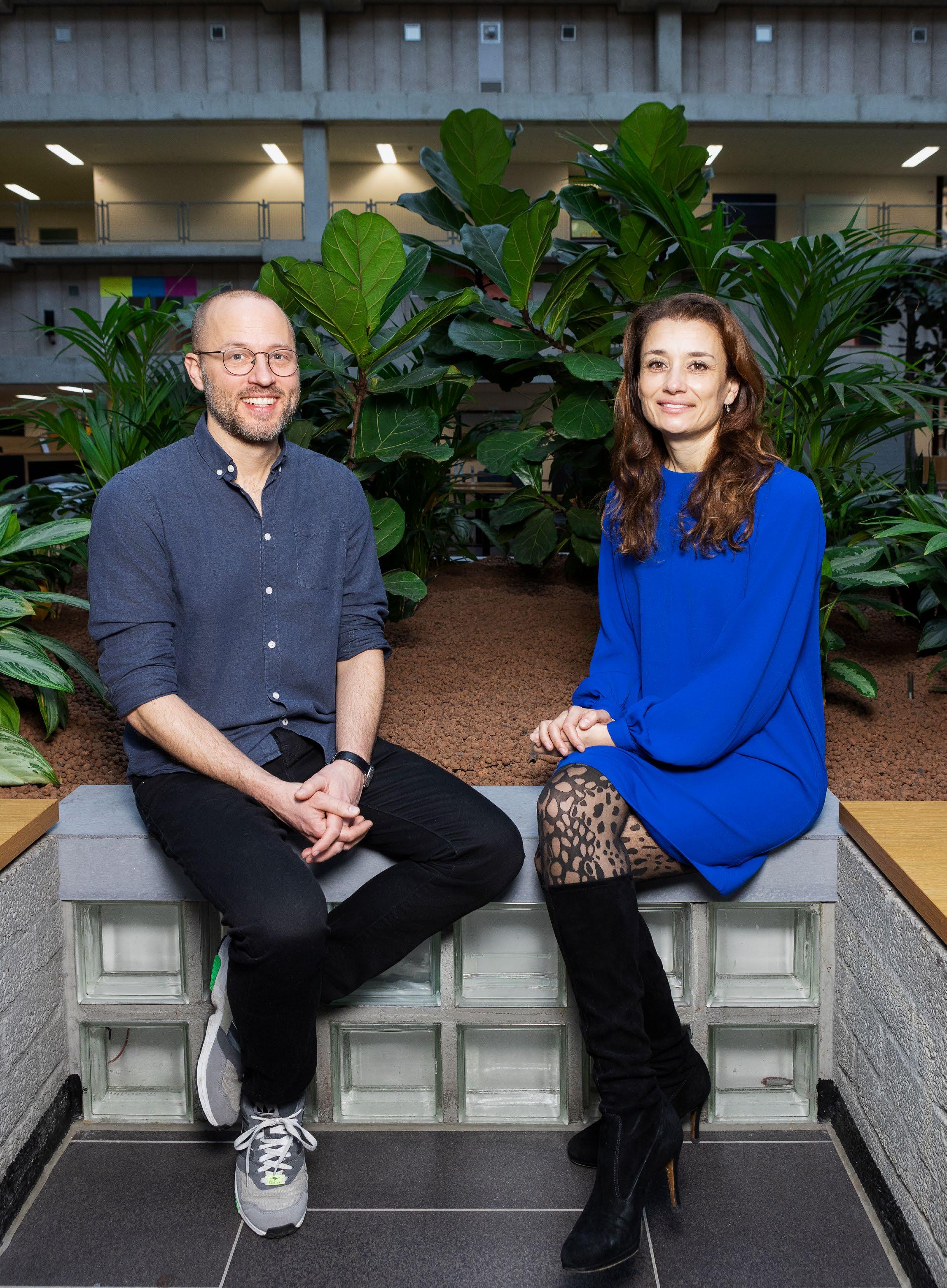
“Healthcare should be made more sustainable”WOUTER HEHENKAMP AND ANNE TIMMERMANS
Climate change, a role for healthcare
Climate change represents a great threat to human health and may be
the biggest problem to solve in the 21st century. With their projects, AR&D researchers Wouter Hehenkamp and Anne Timmermans (both gynecologists), strive to involve all stakeholder groups in order to have the greatest possible impact on making healthcare more sustainable.


SUSTAINABLE HEALTHCARE
Climate change affects all generations, but children may be mostly impacted. Therefore climate change indirectly endangers the human circle of life. Healthcare is responsible for 7% of the carbon gas emissions in the Netherlands. Carbon gas reduction within healthcare is urgently needed in order to reach the target to become a ‘net zero’ healthcare in 2050. Health systems urgently need to transform and build resilience against the consequences of climate change. In order to make steps towards sustainable healthcare we need to gather information on sustainability parameters such as carbon footprints and waste production of different medical treatments. The future and the current health workforces have an essential role in this process. However, also the patients have an important role in this process. It is the responsibility of healthcare to engage patients. Hehenkamp and Timmermans both feel the responsibility to participate in the process towards a sustainable healthcare.
Both intrinsically motivated, they have been working to incorporate sustainability in their daily professional life, with a focus on research and education.
Through their research, Hehenkamp and Timmermans aim to ensure consideration of the different perspectives in sustainability in healthcare. In 2022, Hehenkamp and Timmermans have made steps towards building a sustainability research line in close collaboration with Amsterdam UMC Center for Sustainable Healthcare (CSH). Hehenkamp has formed the CSH research board together with Niek Sperna Weiland (anesthesiologist) and Dionne Kringos (Amsterdam Public Health). Their focus is on quantifying healthcare pathways, investigating patients literacy on climate change and interconnect these two through specific research projects. Since sustainability is a multi-disciplinary research field, they have built a consortium with the Faculty of Social and Behavioral Sciences, the School of Business and
Wouter Hehenkamp Anne TimmermansEconomics and the National Institute for Public Health and the Environment (RIVM).
As an example for the research lines: AR&D awarded a grant to the research team ‘COmparative carbon Footprint assessment oF trEatment options for utErine fibroids (COFFEE)’. In this project, the team aims to calculate the environmental footprint of different fibroid treatments by means of Life Cycle Assessment (LCA). Environmental impact categories are then incorporated into a decision aid for patients. The team will investigate whether patients are willing to incorporate sustainability variables in their decision which treatment they eventually choose. Also, the quantified environmental impact of treatments will guide the team towards ‘hotspots’ to act on as healthcare workers and policy makers. Eventually the team aims to share our methodology with the world in order to inspire other sustainability researchers to do the same, using our methodology (publishing the calculation tool that has been built in this project).
PLANETARY HEALTH IN THE MEDICAL CURRICULUM
Another perspective is the perspective of future healthcare workers. Researchers have called for the inclusion of planetary health in the medical curriculum. Heeding the need for change, a multidisciplinary team at the University of Amsterdam, came together to set up a module on planetary health with the aim of integrating this topic in everyday clinical practice. Besides Dr. Timmermans, this team included Dr. Ines Rupp (public health physician), Dr. Niek
“Healthcare providers, patients and (future) medical students can contribute to sustainable health care.”
Sperna Weiland (anesthesiologist), Dr. Berber Kapitein (pediatrician), and Iris Blom (at the time a final-year medical student). Through a multidisciplinary and intergenerational approach, the team ensured consideration of diverse perspectives in the development process of the module. Teachers prompt students to think about their role in the context of planetary health, for three main reasons. First, the module aims to improve climate literacy and encourage students to share their innovative ideas, thoughts, insights, and solutions. Second, climate change poses an increasing mental health threat because of stress and anxiety, affecting young people most. In addition to knowledge of issues associated with climate change, tools that stimulate solution-based thinking and improve mental health are beneficial. Finally, this approach also aims to stimulate reflection on students’ role in building a climate-conscious, resilient, and environmentally sustainable health workforce, ultimately contributing to planetary health.
The module and its contents were developed in January 2021, and it started in January 2022. With the introduction of this planetary health and sustainability healthcare module in the medical curriculum, the team has started to empower future healthcare workers to take steps towards sustainable healthcare. Furthermore, it offers the possibility to bring research directly back into the classroom. Timmermans together with Marieke Sijm (medical informatician) has formed the education subdivision within Amsterdam UMC Center for Sustainable Healthcare.

“Patient-specific risk factors could aid in the decision making for surgical treatment”LAURENS EEFTINCK SCHATTENKERK, ADINDA PIJPERS AND JOEP DERIKX
Questioning surgical care for young children
AR&D researchers Laurens Eeftinck Schattenkerk (PhD candidate),
Adinda Pijpers (PhD candidate) and Dr. Joep Derikx (pediatric surgeon) argue that challenging the status quo in practice is of utmost importance, as it feeds new research. With their research they focus on pediatric surgery for young children with intestinal atresia.
FIRST STEP IN RESOLVING A PROBLEM IS RECOGNIZING ITS EXISTENCE
One can hardly think of a more frightful situation for parents of a newborn child than to hear that their young infant needs an operation. In this case, the child is born with an atresia in the small intestine, specifically the ileum. This birth defect, which results in a full stop in the intestine, demands an operation within days. Luckily there is a pediatric surgeon to take them by the hand during this hard time. The pediatric surgeon walks the parents through the process stepby-step starting with the operation itself and the postoperative course. The clear explanation and determination of the surgeon puts the parents more at ease but when the surgeon has almost left the room the parents call the surgeon back with one last question: “Are you really sure this is the best treatment for our child?”. Although certain risks and benefits of the treatment will of course be discussed, undoubtedly this is not the time nor the place for our surgeon to answer with: “maybe, maybe not”.
“Comparing surgical treatments can provide the answer to the question which operation is best for children.”
STOMA VERSUS PRIMARY ANASTOMOSIS
In the case of a young patient with an intestinal atresia, there are generally speaking two options. One option is resection of the affected intestine followed by reconnecting the intestine, also called primary anastomosis. The other option is temporary stoma creation, where instead of an anastomosis, the proximal part of the intestine is fixated on the abdominal wall. Later in life, an anastomosis is created during a second operation. The choice between these two treatment strategies is influenced by, among other things, the clinical status of the patient and surgeons’ preference. A prime reason to develop an enterostomy instead of a primary anastomosis, is the fear of postoperative complications such as anastomotic leakage. Research has shown that anastomotic leakage occurs more often in patients receiving a primary anastomosis compared to solely stoma formation. However, by focusing on this sole complication, many other forms of stoma-related morbidity such as infections, depletion of fluids and minerals as a result of high-output stoma and later occurrence of incisional hernia are left out of the equation. Moreover, following stoma reversal, the patient is again exposed to the risk of developing postoperative complications. This leaves the question which treatment truly results in most post-operative complications.
A TRUE COMPARISON OF THE RISKS
The tendency to act like you are sure can, however, result in the creation of certain dogmas in surgical treatment based more on personal experience than on research. Questioning these dogmas might lead to resistance. In psychology this is called status quo bias; preferring to maintain the current situation and opposing actions that may lead to change. However, questioning the status quo is the corner stone of research and if a problem is not taken seriously then it will never be resolved.
Because of these questions, all children treated between 1998 and 2018 in both locations of Amsterdam UMC have retrospectively been evaluated. This cohort consists of more than 2000 children treated for different types of intestinal diseases. AR&D researchers Eeftinck Schattenkerk and Derikx showed that taking in account all patients who received a stoma, the incidence of major stoma morbidity (Clavien-Dindo grade ≥III, meaning resulting in re-operation, ICU admission or death) was 39% when taking into account the operation for both stoma formation and secondary anastomosis. Compared to jejunostomy or colostomies, children treated with an ileostomy were 2.5 times more at risk of these complications. This highlights the necessity of prevention of a stoma, when possible, in these patients.
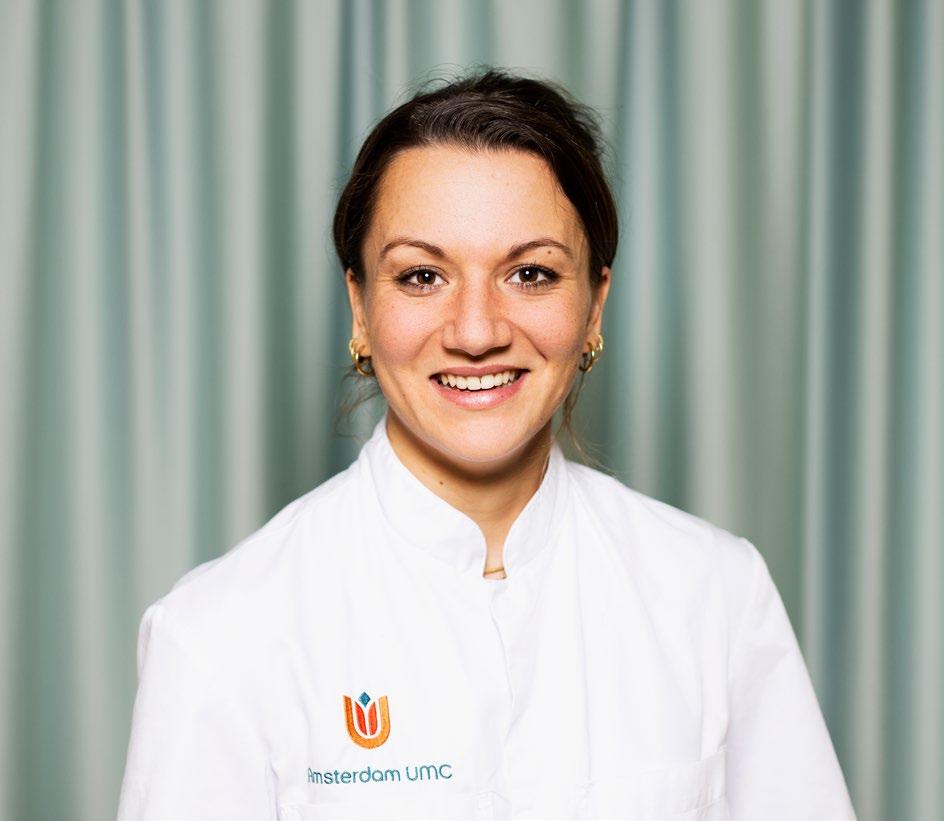

When evaluating all patients who received a primary anastomosis, 5% developed an anastomotic leakage and 8% developed an anastomotic stenosis. An association was found between an increased pre-operative American Society of Anaesthesiology (ASA) score ≥III and male gender with anastomotic leakage. These patient-specific risk factors could aid in the decision making on which treatment to choose, thereby possibly lowering the risk of leakage.
It has to be taken into account that these results are based on all different types of intestinal diseases the team treated over the years. For this reason, the team also looked specifically at patients treated for jejunoileal atresias comparing those treated by stoma to those treated by primary anastomosis. The results showed that significantly more severe
postoperative complications occurred following treatment by enterostomy. Moreover, both short-term (surgical site infection, wound dehiscence) and longterm (short bowel syndrome, adhesive bowel obstruction) complications occurred significantly more in those treated by enterostomy. Lastly, no significant difference was found in occurrence of anastomotic leakage, stenosis and mortality rates between both treatment strategies.
FUTURE RESEARCH ON RISK FACTORS FOR COMPLICATIONS
Because of these risks of enterostomy creation and the relatively low incidence of anastomotic leakage the current preference of treatment is now primary anastomosis. Though perioperative factors might still demand stoma formation. In the future, the
team hopes to identify more patient-related risk factors for complications. These could aid surgeons in the decision when to perform a primary anastomosis. These factors can be based on clinical studies but also fundamental studies, evaluating both the biological process of intestinal anastomotic healing as well as the influence of the microbiome which is being researched in a joint effort between the Pediatric Surgery department and the Tytgat Institute (Prof. Wouter de Jonge).
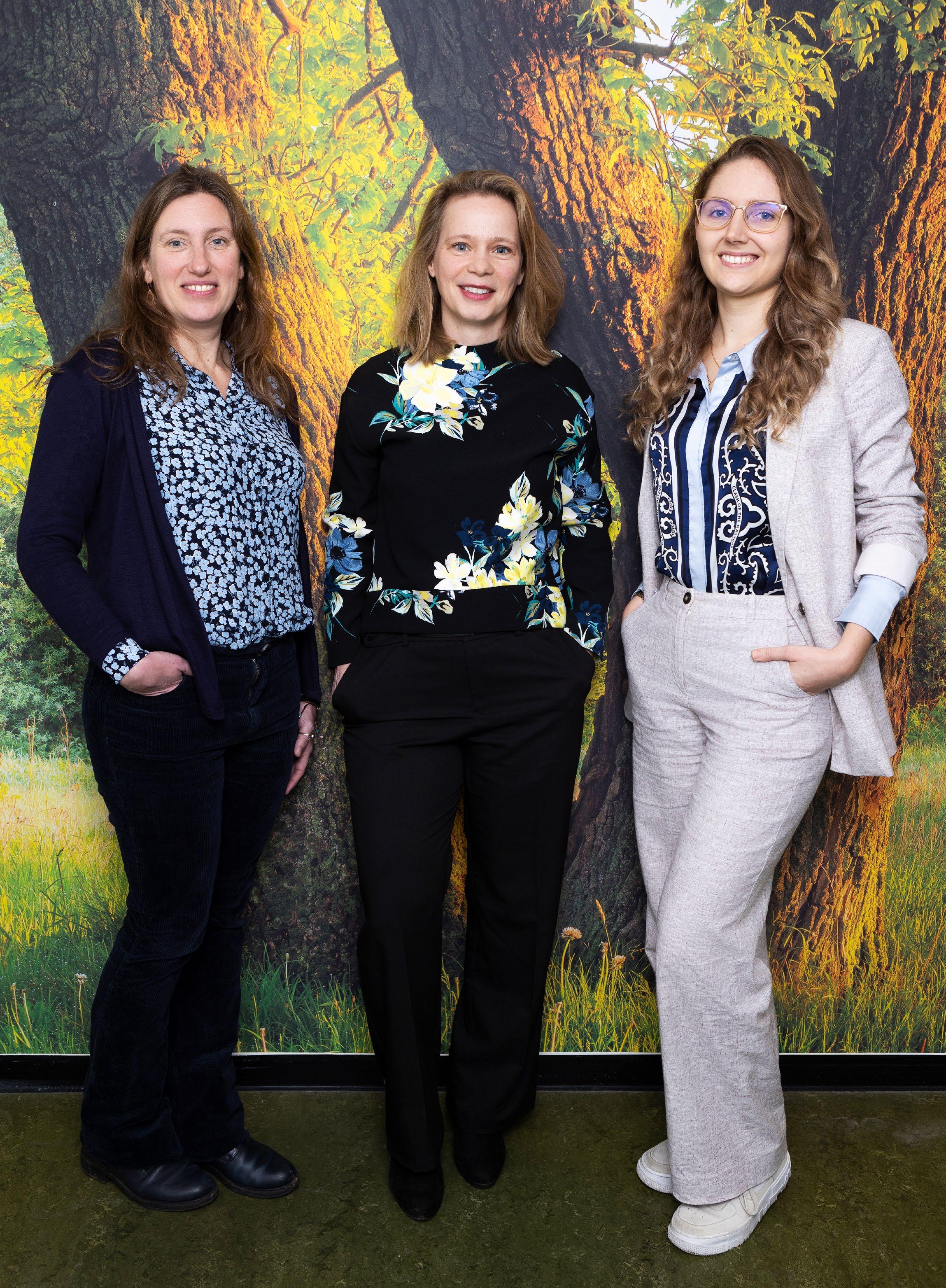
“Interdisciplinary team science, using human and animal models to understand how early life adversity affects brain aging”ANIKO KOROSI, SUSANNE DE ROOIJ AND AMBER BOOTS
Early life origins of dementia
Early environmental exposures may have long lasting consequences. The group of researchers who have been studying the long term consequences of prenatal exposure to the Dutch famine are now exploring effects on aging.
It is increasingly being recognized that neurodegenerative diseases start many years before clinical symptoms become apparent. However, it is now emerging that the basis for risk of developing neurodegenerative diseases goes much further back and may be laid in the very earliest stages of life. This may seem like a long shot, literally, as the diagnosis of diseases like Alzheimer’s disease usually occurs towards the end of life, and the factors playing 70 to 80 years before that may not seem significant. However, considering that the structural and functional organization of the adult brain is mostly laid down during pregnancy and the early postnatal years and we largely have to deal with these for the rest of our lives, it is plausible that aberrations in these early processes make the brain more vulnerable for disease in later life.
PRENATAL EXPOSURES AND BRAIN DEVELOPMENT
In a recently published systematic review, AR&D researchers Amber Boots, Susanne de Rooij and Aniko Korosi reported that factors related to a suboptimal prenatal environment, such as a low or high birth weight or being born in an area characterized by a high infant mortality rate, are associated with an increased dementia risk (Boots et al. Neurosci Biobehav Rev, 2023). An additional systematic review by the team provided a convincing body of evidence showing that brain volumes in regions associated with Alzheimer Disease are often smaller after adverse prenatal exposures, including prenatal exposure to various harmful substances (e.g. alcohol and drugs), placental dysfunction and maternal anemia (Wiegersma et al. Soc Psych 2023). With smaller brain volumes in these areas constituting a risk factor for the development of Alzheimer Disease, this suggests that the negative effect of adverse prenatal exposures on brain growth may be one of the ways that these factors increase the risk for Alzheimer Disease.
DUTCH FAMINE BIRTH COHORT STUDY
Studying the potential early life origins of dementia in humans is very challenging given the long time lag between exposure and
“The Dutch famine birth cohort offers a unique opportunity for research on aging.”
disease. Studies are usually dependent on retrospective reporting of early life adversity by older participants, which is hampered by difficulties memorizing this. The Dutch famine birth cohort investigates the longterm health consequences of prenatal exposure to undernutrition. With cohort members currently aging, this offers a unique opportunity to study potential associations with brain aging and cognitive decline and dementia. Using cognitive testing and MRI neuroimaging, De Rooij and Boots have so far demonstrated that especially undernutrition during early gestation seems to modulate the risk for dementia. Exposure to famine in early gestation was associated with decreased selective attention at age 58 and especially in men also with smaller brain volumes, worse brain perfusion, higher BrainAge and patterns of resting state functional connectivity network desegregation fitting with brain aging. Currently, they are studying longitudinal changes in brain structure and function in these individuals.
PRECLINICAL MODELS
The observational evidence in humans is corroborated by findings from preclinical models in which early life adversity has been shown to promote cognitive decline at a later age and to accelerate aging, both primary risk factors for Alzheimer Disease. Korosi and her group utilize exposure to an impoverished environment (limited nesting and bedding) during the first week of life in mice to investigate the effects early life stress in the offspring. When exposing



predictable transgenic Alzheimer Disease mouse models (APP/PS1) to early life stress, these exhibit further impairment in cognition, increased amyloid plaque deposition and excessive neuroinflammatory response. Korosi is currently exploring if these effects might be mitigated with an anti-inflammatory diet improved with fatty acids.
INTERDISCIPLINARY RESEARCH
Observing the complementarities between their lines of research, and with an eye for the importance of translation of preclinical models to humans, Korosi and De Rooij decided to join forces. With a grant from the UvA Amsterdam Brain and Cognition (ABC), they were able to set up a collaboration studying lipids and fatty acids as potential mediators in the relation between early life stress and cognitive decline later in life. Their collaborative work led to their mutual participation in a large international collaboration receiving a grant from the EU Joint Program for Neurodegenerative
Disease Research in 2022. The project is aimed at identifying early biomarkers of neurodegeneration and cognitive decline. In addition, the team also acquired funding from Alzheimer Nederland to investigate whether early life stress might increase Alzheimer Disease risk by instigating mitochondrial dysfunction and whether this can be targeted among others via dietary strategies. With these funds for research, the interdisciplinary team will now focus on early biomarkers predictive of cognitive dysfunction and neurodegeneration in the animal as well as human equivalent of their early life adversity studies and will employ the animal model to investigate the causal role of early life adversity in predisposition to Alzheimer Disease as well as diet-based strategies (early and later in life) for alleviating these effects. In the long-term, the team hopes to be able to contribute to a better understanding of the role of early life adversity in brain aging and neurodegenerative diseases and to find targets for prevention.
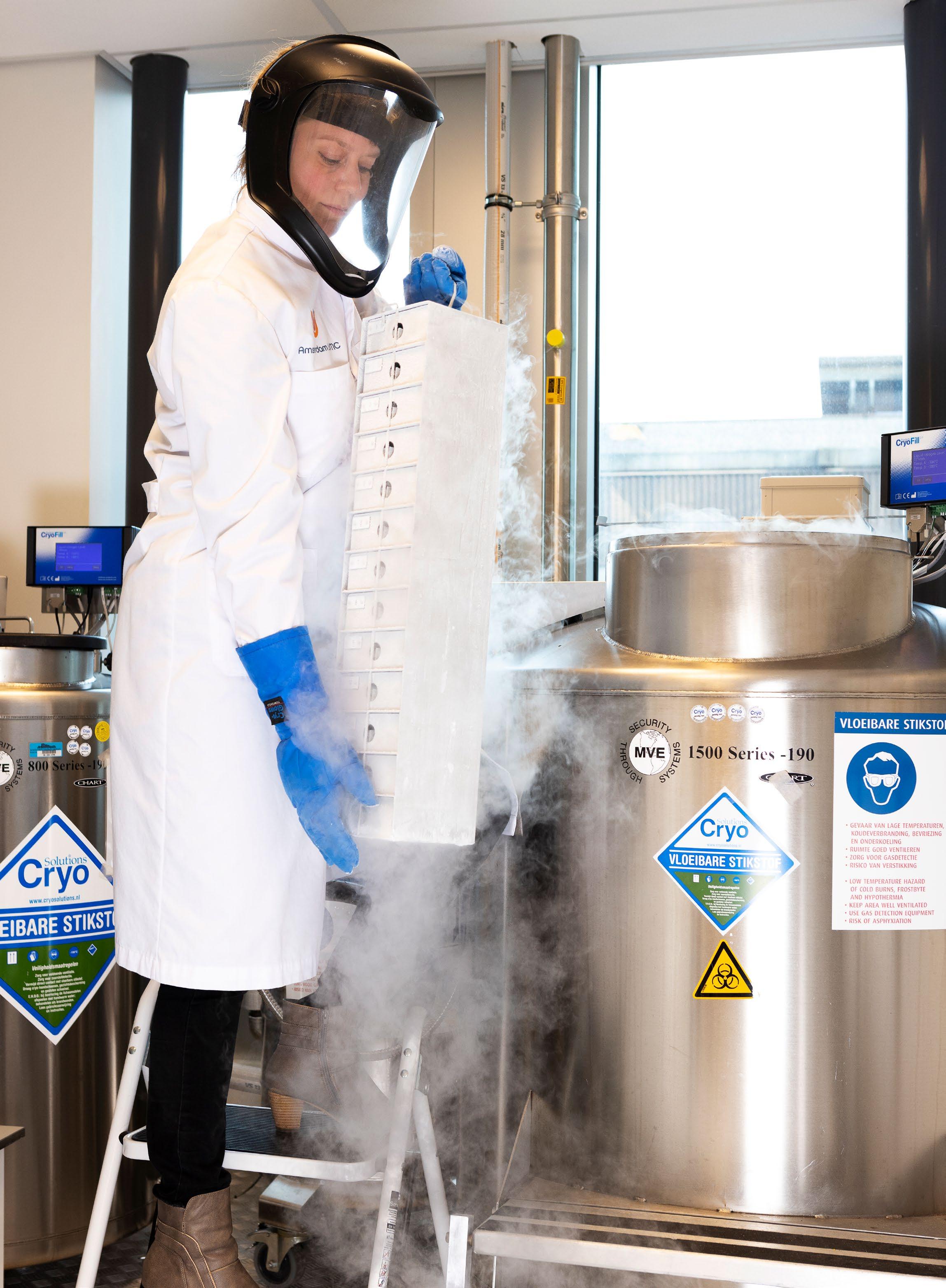
“Hopefully with our research, cancer survivors can increasingly have biological children”JILLIS VAN MAAREN, CALLISTA MULDER AND ANS VAN PELT
Towards a fertile future for male childhood cancer survivors
Although improved treatments have increased survival rates in childhood cancer patients, they are also increasingly confronted with late effects of treatment, including infertility. Research at the Reproductive Biology Laboratory brings hope.

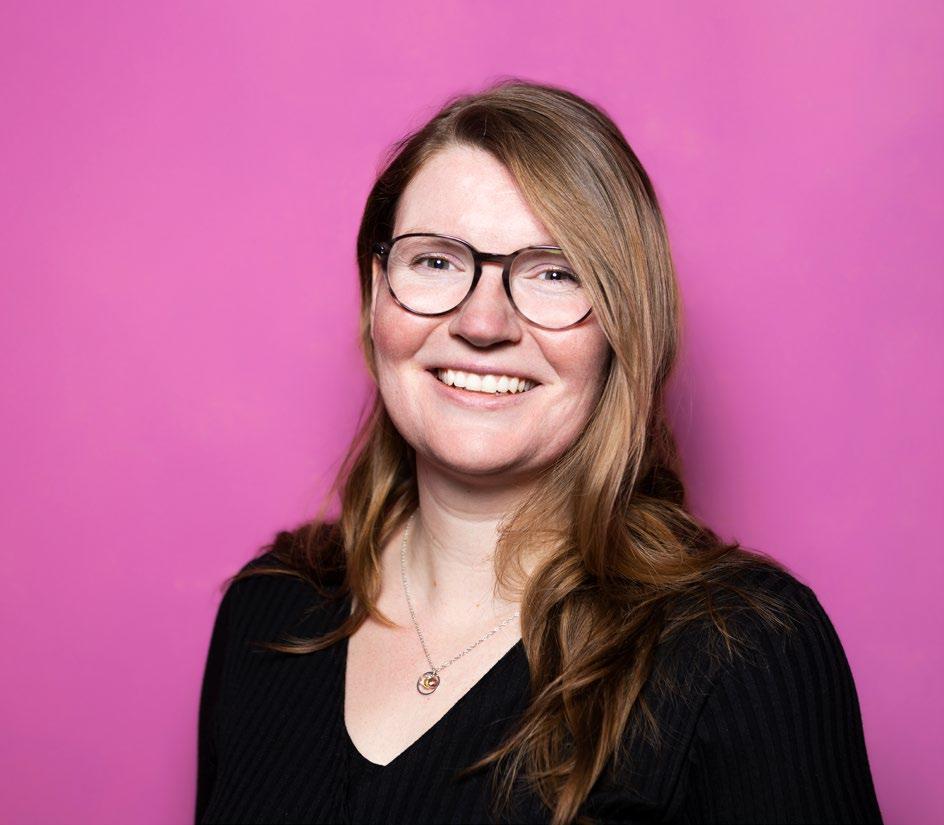

CANCER-FREE, BUT CHILDLESS
Cured of their cancer, some cancer survivors are still held back by the chains of their disease. Life-saving treatments such as chemoand radiotherapy can cause irreversible damage to the testicular spermatogonial stem cells (SSCs). These SSCs, which are present in the testes from birth onwards, are the precursors of sperm and therefore the key to male fertility. Once destroyed by gonadotoxic treatments, biological parenthood is out of question. The Reproductive Biology Laboratory, led by professor Ans van Pelt, aims to renew the hope, and ability, for these men to have children of their own.
PRESERVATION AND POSSIBLE RESTORATION OF FERTILITY
Since 2009, Amsterdam UMC has offered fertility preservation to parents of boys at risk of becoming infertile, by cryopreserving a biopsy of the testis prior to treatment. As, worldwide, these boys are now reaching adult ages, the development of a fertility restoration treatment is an urgent topic in the field of male reproductive biology and medicine. In the Reproductive Biology
Laboratory, this is exactly what AR&D researchers Jillis van Maaren, Callista Mulder and Ans van Pelt are working on. Within five years, they hope to achieve clinical application of spermatogonial stem cell autotransplantation (SSCT). This potential treatment uses the patient’s preserved testicular biopsy to isolate, propagate the SSCs and re-inject them into the testes. There, the SSCs can migrate to their natural niche and re-establish spermatogenesis within the tissue. Natural conception of children without additional reproductive techniques such as in vitro fertilization will then be possible.
SAFETY FIRST
Current research into SSCT is done within the ZonMw TAS project (in Dutch: Translationeel Adult Stamcelonderzoek). As safety is of course a major concern with any new therapy, studies have been performed in a mouse model to establish the safety of the procedure for both the cancer survivor and his future children. The procedure itself involves an injection of SSCs into the testes and mouse studies have shown that this is well tolerated without acute or chronic side
Callista Mulder Jillis van Maaren Ans van Pelteffects. Furthermore, within two generations of naturally conceived mice born from a SSCtransplanted male, no increase in congenital and developmental abnormalities was found. Throughout life, SSCT-derived mice showed no increased risk of cancer or metabolic diseases. These findings are crucial in working towards a potential therapy, which patients should feel secure to pursue.
CONCERNING SSCS – MORE IS BETTER
A crucial part of SSCT is the culture of SSCs to increase their number prior to transplantation, because the number of SSCs obtained from a pre-pubertal testicular biopsy is considered too small for effective restoration of spermatogenesis. Therefore, PhD candidate Van Maaren studies how various culture conditions might benefit the proliferation of the SSCs. Multiple factors, including the culture temperature and specific components of the culture medium appear to have a profound influence. In parallel, Van Maaren establishes methods to upscale the current lab-based culture to clinical volumes and methods consistent with Advanced Therapeutic Medicinal Product (ATMP) regulations. This research hinges on the availability of human testicular tissue, which is difficult to obtain. Therefore, the group is very grateful for previously donated testicular tissue from orchiectomies of prostate cancer patients from the Amsterdam UMC Urology Department. Additionally, through a recently established cooperation with the Center for
“Safety of Spermatogonial stem cell autotransplantation is of course of utmost importance.”
Gender Dysphoria, spare testicular tissue is donated by transwomen after genderaffirming surgery.
TOWARDS A CLINICAL TRIAL, AND HOPE
Van Pelt is enthusiastic about progressing to this pharmaceutical phase. Currently, a Central Committee on Research Involving Human Subjects (CCMO)-request is being prepared to ask permission for a first clinical trial. In support of this application, Mulder is leading a qualitative study to uncover the perspectives of childhood cancer survivors regarding their experiences with fertility preservation and wishes and concerns for possible future fertility restoration. The importance of this study has been recognized by ZonMw as well, who in December 2022 have allocated a VIMP (in Dutch: Verspreidings- en Implementatie-impuls) grant to the research group to execute this work. The study will be conducted in cooperation with a pediatric oncologist, psychologist and late-effect practitioners of the Prinses Máxima Centrum in Utrecht, a representative of the Vereniging Kinderkanker Nederland, and an ethicist of Leiden UMC.
Cancer can take away much from the life of survivors, including the ability to make certain choices to live it. Though a lot of work remains to be done, Van Pelt and her team are hopeful that for these patients hope may again be restored of having their biologically own children one day.

“We aim to provide a much needed bridge between practice and science for people with genetic disorders”ANNELIEKE MULLER AND AGNIES VAN EEGHEN
Personalized medicine for rare genetic neurodevelopmental disorders
About one-third of the Emma Children’s Hospital population, and up to 3% of the Dutch general population, consists of individuals with (rare) genetic neurodevelopmental disorders, such as Down Syndrome, 16p11.2 duplication syndrome, and Williams Syndrome. These disorders are accompanied by many complex physical and mental problems, and have a great impact on functioning and quality of life, for children as well as their families. Even though knowledge on these disorders is increasing, there is a currently lack of therapies. This calls for a framework of personalized medicine trial methodology for rare disorders.
“For rare diseases, a powerful alternative for RCTs are the N-of-1 designs.”
EVIDENCE-BASED CARE
AR&D researchers Annelieke Muller (PhDcandidate), and Dr. Agnies van Eeghen, intellectual disability physician (in Dutch: Arts voor Verstandelijk Gehandicapten), work both at the Emma Children’s Hospital and ‘s Heeren Loo, the largest Dutch care organization for individuals with an intellectual disability (ID). Within the research group of Van Eeghen, the main focus is on the development of therapies and outcome measures for individuals with rare genetic neurodevelopmental disorders (RGNDs) and/ or ID. To identify targets for treatment and prevention, the group studies the natural history of several genetic syndromes, with a focus on neuropsychiatric manifestations. To get all this knowledge into care nationally and worldwide, they are improving guideline methodology with the European Reference Network for Rare Malformation Syndromes, Intellectual and Other Neurodevelopmental Disorders (ERN ITHACA). ERN ITHACA is a patient-centered network that meets the needs of those individuals for highly
specialized, multidisciplinary healthcare, providing an infrastructure for diagnosis, evidence-based management and collecting data.
TOWARDS PERSONALIZED TRIALS
The PhD project of Muller concerns interventions and outcome measures in genetic syndromes, focusing on alternative trial designs to enable personalized and evidence-based care. Interventional research in this population is quite challenging. Traditional randomized controlled trials are often not feasible, because of the rarity of the specific disorders, vulnerability of patients, and the heterogeneity between and within disorders. Powerful alternatives are singlecase experimental designs (SCEDs), such as the N-of-1 design and the multiple baseline or stepped wedge design. In this type of study, the patient is his or her own control. Despite of its great potential to provide evidence of effectiveness for individuals as well as groups of patients, N-of-1 studies (randomized, placebo-controlled multiple crossover trials)
are sporadically performed in RGNDs. Based on a systematic review that was performed recently by the team, recommendations for future N-of-1 studies are provided. Also, several N-of-1 clinical trials were started to investigate the effectiveness of different interventions for genetic disorders. For example, the team is investigating the efficacy of novel treatments for shared comorbidity in these disorders.
They study the potential effects of cannabidiol (CBD) for severe behavioral manifestations in a proper scientific yet personalized way. An N-of-1 trial will start soon in 30 children and adults with Fragile X syndrome, Tuberous Sclerosis Complex and Sanfilippo, including various personalized


outcome measures. Furthermore, there are questions on the effectiveness and side effects of methylphenidate in patients with neurodevelopmental problems. To study this, an N-of-1 series of studies begins to investigate the effectiveness of methylphenidate for Attention Deficit Hyperactivity Disorder (ADHD) symptoms in Smith-Magenis syndrome, as this medication has been commonly used in clinical practice in this patient population.
In addition, the team is piloting different types of SCEDs in the clinic to gather evidence for treatments at the individual level, while hopefully also collecting cases for larger series. Different trial designs are proposed to the patient or family members and relevant
outcomes are discussed (see figure on page 31). Based on the patient preference, such as whether placebo or withdrawal of the intervention could be introduced, trials were started.
MEASURING WHAT MATTERS
Only adjusting trial designs for patients is not enough. It is important to know what matters to them and incorporate these outcomes into trials, especially in such a heterogeneous population where health manifestations and treatment goals differ a lot. There is a great need for outcome measures that are relevant to patients, including patient-reported outcome measures (PROMs) and digital apps. As there are many available outcome measures, the team started a scoping review to provide an overview of which outcome measurement instruments have been used in clinical trials. Moreover, they developed and validated a disorder-specific PROM for Tuberous Sclerosis (the TSC-PROM) to assess health-related quality of life, which can be used in both clinical settings and research settings. Furthermore, the team is working on personalized outcome measures, such as experience sampling methodology (ESM), which includes real-time data collection on multiple occasions within the day and over time, and Goal Attainment Scaling (GAS). Prior to a treatment, goals are identified that are
relevant to the patient together with the patient and family or caregivers. Goals could be different for each patient, but it has to do with the construct that the treatment will target. In this way, outcome measures can be used that are specifically relevant to the patient, which eventually enhances treatment adherence as well. Also, policy makers such as the Medicines Evaluation Board, European Medicines Agency, and Food and Drug Administration are very interested in these types of outcome measures, with implications for registration or reimbursement.
FROM INTELLECTUAL DISABILITY TO DISORDER-SPECIFIC CARE
Last but not least, the team wants to improve personalized care in the ID field. With advances in genetic technology they can increasingly identify a genetic diagnosis in individuals with an ID. Knowledge on the etiology of ID helps clinical management by involved medical doctors such as ID physicians, as well as other members of the multidisciplinary team such as psychologists, dieticians, and professional caregivers. They can use this information on the genetic etiology for education, (psychological) interventions (e.g. for anxiety or self-injurious behavior which is common in specific genetic syndromes), and understanding and treating disorder-specific manifestations (e.g. obesity
N-of-1-design
Multiple baseline design
in 16p11.2 deletion syndrome, anxiety in Fragile X syndrome or epilepsy in Tuberous Sclerosis Complex). However, it is unclear to what extent information on genetic etiology has been implemented into multidisciplinary care. Therefore, the team started a cross-sectional study at ‘s Heeren Loo to examine the current clinical practice with regard to genetic diagnostics and multidisciplinary care. They aimed to study how often a genetic cause was reported, by whom (such as (ID) physicians, behavioral therapists or caregivers), and what clinical and demographical factors were associated with presence of the information on genetic etiology. Results will be published soon, but to get a first glimpse of the findings: a minority of individuals with an ID has received genetic testing. Results were mainly reported in the files by physicians and caregivers, and less frequently by behavioral
therapists. Level of ID, age, and who the legal representative was, were associated with initiating genetic testing. More research is necessary to identify facilitators and barriers for genetic testing, and to enable disorderspecific, holistic care.
For these projects, the team gets a help from colleagues, such as the pediatricians and colleagues from the Women and Child Center (VKC), Psyche and Departments of Psychiatry, Neurology, Community Genetics and Human Genetics, the Alzheimer Center; and many more. Together, they aim to provide evidence-based interventions and tailored care for the vulnerable and under-researched patient population, providing a much needed bridge between practice and science. This is also the aim of the Emma Center for Personalized Medicine (see page 53).
“The ambition of AR&D is the advancement of knowledge in all aspects of human reproduction and development through interdisciplinary team science aimed at improving health from preconception to adulthood of current and future generations”
“Unique about the research institute Amsterdam Reproduction & Development is that we pay attention to reproduction and development in its totality: the stage before pregnancy, conception, pregnancy, childbirth, the child as it’s growing up, and the resulting health of the adult stages of life”
